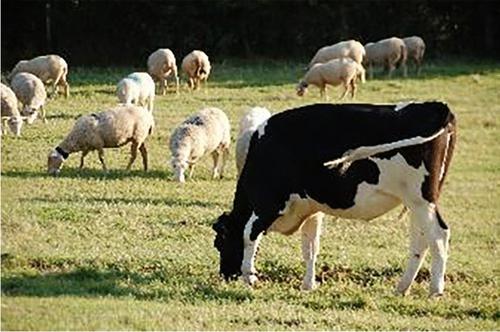Agronomy for Sustainable Development ( IF 7.3 ) Pub Date : 2023-11-13 , DOI: 10.1007/s13593-023-00930-8 Marc Benoit , Guillaume Martin , Lucille Steinmetz , Dephne Ulukan , Gun Bernes , Christopher Brock , Anne De La Foye , Myriam Grillot , Marie-Angelina Magne , Tabea Meischner , Marie Moerman , Leonardo Monteiro , Bernadette Oehen , David Parsons , Riccardo Primi , Lisa Schanz , Christoph Winckler , Bertrand Dumont

|
One of the key ways to improve the sustainability of agricultural systems is through diversification, taking advantage of synergies between farm enterprises. Among diversified systems, multispecies livestock farms with at least two animal enterprises have rarely been studied. We explored 95 organic farms from six countries, accounting for the proportion of animal enterprises, sales management, workforce size, and work organization. The study reveals various types of interactions between animal enterprises. Complementarities were observed between ruminant and monogastric enterprises, particularly fertilizer transfer from monogastric manure to grasslands. Milk production was often associated with on-farm processing and short distribution channels, which enhanced farm viability and reduced its dependency on herd productivity. Eleven out of the 95 farms combined above-average production efficiency, on-farm processing, and the majority of sales in short distribution channels. Their labor productivity converged toward 22 livestock units per annual work unit, regardless of the number of workers. Combining farm structure; livestock production efficiency; social elements, such as the workforce; and sales management led us to distinguish four types of farms: (i) small and very autonomous grassland farms with on-farm processing and short distribution channels; (ii) dairy farms associated with a high-density pig or poultry enterprise, whose feed purchase contributes to high rates of cattle feeding self-sufficiency and stocking rate; (iii) large farms with an extensive, grassland beef enterprise associated with either sheep or monogastrics; and (iv) dairy sheep associated with goat or beef cattle on rangelands, with high added-value products enhancing salaries. This study highlights for the first time the diversity of organic multispecies livestock farms and how consistent patterns of interactions among farm structure, livestock management, sales management, and workforce management shape them. The results are a preliminary basis for designing policy interventions aiming to scale up organic farming and value social assets of diversified and small farms.
中文翻译:

动物企业和营销策略之间的相互作用塑造了有机多物种农业系统
提高农业系统可持续性的关键方法之一是通过多元化,利用农业企业之间的协同效应。在多样化系统中,至少有两个动物企业的多品种畜牧场很少被研究。我们考察了来自6个国家的95个有机农场,从动物企业的比例、销售管理、劳动力规模和工作组织等方面进行了调查。该研究揭示了动物企业之间各种类型的相互作用。在反刍动物和单胃动物企业之间观察到互补性,特别是从单胃动物粪便到草原的肥料转移。牛奶生产通常与农场加工和较短的分销渠道相关,这增强了农场的生存能力并减少了对牛群生产力的依赖。95 个农场中,有 11 个农场的生产效率高于平均水平,农场内进行加工,并且大部分销售均通过较短的分销渠道进行。无论工人数量有多少,他们的劳动生产率都趋向于每工作单位 22 头牲畜。结合农场结构;畜牧生产效率;社会因素,例如劳动力;和销售管理使我们区分了四种类型的农场:(i)小型且高度自治的草原农场,具有农场加工和较短的分销渠道;(ii) 与高密度生猪或家禽企业相关的奶牛场,其饲料采购有助于提高牛饲养自给率和存栏率;(iii) 拥有与绵羊或单胃动物相关的广泛草原牛肉企业的大型农场;(iv) 牧场上与山羊或肉牛相关的奶羊,其高附加值产品可提高工资。这项研究首次强调了有机多品种畜牧场的多样性,以及农场结构、牲畜管理、销售管理和劳动力管理之间一致的相互作用模式如何塑造它们。研究结果为设计政策干预措施奠定了初步基础,旨在扩大有机农业规模并重视多元化和小型农场的社会资产。



























 京公网安备 11010802027423号
京公网安备 11010802027423号